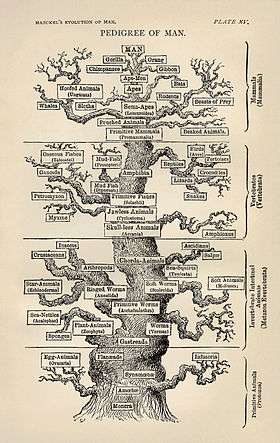Cell biology
Cell biology (also cellular biology or cytology) is a branch of biology studying the structure and function of the cell, also known as the basic unit of life.[1] Cell biology encompasses both prokaryotic and eukaryotic cells and can be divided into many sub-topics which may include the study of cell metabolism, cell communication, cell cycle, biochemistry, and cell composition. The study of cells is performed using several techniques such as cell culture, various types of microscopy, and cell fractionation. These have allowed for and are currently being used for discoveries and research pertaining to how cells function, ultimately giving insight into understanding larger organisms. Knowing the components of cells and how cells work is fundamental to all biological sciences while also being essential for research in biomedical fields such as cancer, and other diseases. Research in cell biology is interconnected to other fields such as genetics, molecular genetics, biochemistry, molecular biology, medical microbiology, immunology, and cytochemistry.
| Part of a series on |
| Biochemistry |
|---|
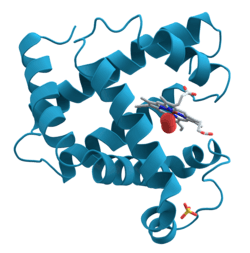 |
| Key components |
| History of Biochemistry |
| Glossaries |
|
| Portals: Biochemistry |
History
Cells were first seen in 17th century Europe with the invention of the compound microscope. In 1665, Robert Hooke termed the building block of all living organisms as "cells" after looking at a piece of cork and observing a cell-like structure,[2] however, the cells were dead and gave no indication to the actual overall components of a cell. A few years later, in 1674, Anton Van Leeuwenhoek was the first to analyze live cells in his examination of algae. All of this preceded the cell theory which states that all living things are made up of cells and that cells are the functional and structural unit of organisms. This was ultimately concluded by plant scientist, Matthias Schleiden and animal scientist, Theodor Schwann in 1839, who viewed live cells in plant and animal tissue, respectively.[3] 19 years later, Rudolf Virchow further contributed to the cell theory, adding that all cells come from the division of pre-existing cells.[3] Although widely accepted, there have been many studies that question the validity of the cell theory. Viruses, for example, lack common characteristics of a living cell, such as membranes, cell organelles, and the ability to reproduce by themselves.[4] Scientists have struggled to decide whether viruses are alive or not and whether they are in agreement with the cell theory.
Techniques
Modern-day cell biology research looks at different ways to culture and manipulate cells outside of a living body to further research in human anatomy and physiology, and to derive medications. The techniques by which cells are studied have evolved. Due to advancements in microscopy, techniques and technology have allowed for scientists to hold a better understanding of the structure and function of cells. Many techniques commonly used to study cell biology are listed below:[5]
- Cell culture: Utilizes rapidly growing cells on media which allows for a large amount of a specific cell type and an efficient way to study cells.[6]
- Fluorescence microscopy: Fluorescent markers such as GFP, are used to label a specific component of the cell. Afterwards, a certain light wavelength is used to excite the fluorescent marker which can then be visualized.[6]
- Phase-contrast microscopy: Uses the optical aspect of light to represent the solid, liquid, and gas phase changes as brightness differences.[6]
- Confocal microscopy: Combines fluorescence microscopy with imaging by focusing light and snap shooting instances to form a 3-D image.[6]
- Transmission electron microscopy: Involves metal staining and the passing of electrons through the cells, which will be deflected upon interaction with metal. This ultimately forms an image of the components being studies.[6]
- Cytometry: The cells are placed in the machine which uses a beam to scatter the cells based on different aspects and can therefore separate them based on size and content. Cells may also be tagged with GFP-florescence and can be separated that way as well.[7]
- Cell fractionation: This process requires breaking up the cell using high temperature or sonification followed by centrifugation to separate the parts of the cell allowing for them to be studied separately.[6]
Cell classification and composition
There are two fundamental classifications of cells: prokaryotic and eukaryotic. Prokaryotic cells are distinguished from eukaryotic cells by the absence of a cell nucleus or other membrane bound organelle.[8] Prokaryotic cells are much smaller than eukaryotic cells, making them the smallest form of life.[9] The study of eukaryotic cells is typically the main focus of cytologists, whereas prokaryotic cells are the focus of microbiologists.
Prokaryotic cells

Prokaryotic cells include Bacteria and Archaea, and lack an enclosed cell nucleus. They both reproduce through binary fission. Bacteria, the most prominent type, have several different shapes which include mainly spherical, and rod-shaped. Bacteria can be classed as either gram positive or gram negative depending on the cell wall composition. Bacterial structural features include:
- Flagella: A tail-like structure that helps the cell to move.[10]
- Ribosomes: Used for translation of RNA to protein.[10]
- Nucleoid: Area designated to hold all the genetic material in a circular structure.[10]
There are many process that occur in prokaryotic cells that allow them to survive. For instance, in a process termed conjugation, fertility factor allows the bacteria to possess a pilus which allows it to transmit DNA to another bacteria which lacks the F factor, permitting the transmittance of resistance allowing it to survive in certain environments.[11]
Eukaryotic cells
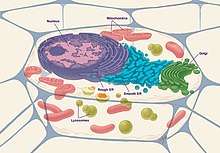
Eukaryotic cells can either be unicellular or multicellular[10] and include animal, plant, fungi, and protozoa cells which all contain organelles with various shapes and sizes.[12] These cells are composed of the following organelles:
- Nucleus: This functions as the genome and genetic information storage for the cell, containing all the DNA organized in the form of chromosomes. It is surrounded by a nuclear envelope, which includes nuclear pores allowing for transportation of proteins between the inside and outside of the nucleus.[13] The is also the site for replication of DNA as well as transcription of DNA to RNA. Afterwards, the RNA is modified and transported out to the cytosol to be translated to protein.
- Nucleolus: This structure is within the nucleus, usually dense and spherical in shape. It is the site of ribosomal RNA (rRNA) synthesis, which is needed for ribosomal assembly.
- Endoplasmic reticulum (ER): This functions to synthesize, store, and secrete proteins to the golgi apparatus.[14]
- Mitochondria: This functions for the production of energy or ATP within the cell. Specifically, this is the place where the Krebs cycle or TCA cycle for the production of NADH and FADH occurs. Afterwards, these products are used within the electron transport chain (ETC) and oxidative phosphorylation for the final production of ATP.[15]
- Golgi apparatus: This functions to further process, package, and secrete the proteins to their destination. The proteins contain a signal sequence which allows the golgi apparatus to recognize and direct it to the correct place.[16]
- Lysosome: The lysosome functions to degrade material brought in from the outside of the cell or old organelles. This contains many acid hydrolases, proteases, nucleases, and lipases, which breakdown the various molecules. Autophagy is the process of degradation through lysosomes which occurs when a vesicle buds off from the ER and engulfs the material, then, attaches and fuses with the lysosome to allow the material to be degraded.[17]
- Ribosomes: Functions to translate RNA to protein.
- Cytoskeleton: This functions to anchor organelles within the cells and make up the structure and stability of the cell.
- Cell membrane: The cell membrane can be described as a phospholipid bilayer and is also consisted of lipids and proteins.[10] Because the inside of the bilayer is hydrophobic and in order for molecules to participate in reactions within the cell, they need to be able to cross this membrane layer to get into cell via osmotic pressure, diffusion, concentration gradients, and membrane channels.[18]
- Centrioles: Function to produce spindle fibers which are used to separate chromosomes during cell division.
Eukaryotic cells may also be composed of the following molecular components:
Processes
Cell metabolism
Cell metabolism is necessary for the production of energy for the cell and therefore its survival and includes many pathways. For cellular respiration, once glucose is available, glycolysis occurs within the cytosol of the cell to produce pyruvate. Pyruvate undergoes decarboxylation using the multi-enzyme complex to form acetyl coA which can readily be used in the TCA cycle to produce NADH and FADH2. These products are involved in the electron transport chain to ultimately form a proton gradient across the inner mitochondrial membrane. This gradient can then drive the production of ATP and H2O during oxidative phosphorylation.[19] Metabolism in plant cells includes photosynthesis which is simply the exact opposite of respiration as it ultimately produces molecules of glucose.
Cell communication and signaling
Cell communication is important for cell regulation and for cells to process information from the environment and respond accordingly. Communication can occur through direct cell contact or endocrine, paracrine, and autocrine signaling. Direct cell-cell contact is when a receptor on a cell binds a molecule that is attached to the membrane of another cell. Endocrine signaling occurs through molecules secreted into the bloodstream. Paracrine signaling uses molecules diffusing between two cells to communicate. Autocrine is a cell sending a signal to itself by secreting a molecule that binds to a receptor on its surface. Forms of communication can be through:
- Ion channels: Can be of different types such as voltage or ligand gated ion channels. The allow for the outflow and inflow of molecules and ions.
- G-protein coupled receptor (GPCR): Is widely recognized to contain 7 transmembrane domains. The ligand binds on the extracellular domain and once the ligand binds, this signals a guanine exchange factor to convert GDP to GTP and activate the G-α subunit. G-α can target other proteins such as adenyl cyclase or phospholipase C, which ultimately produce secondary messengers such as cAMP, Ip3, DAG, and calcium. These secondary messengers function to amplify signals and can target ion channels or other enzymes. One example for amplification of a signal is cAMP binding to and activating PKA by removing the regulatory subunits and releasing the catalytic subunit. The catalytic subunit has a nuclear localization sequence which prompts it to go into the nucleus and phosphorylate other proteins to either repress or activate gene activity.[19]
- Receptor tyrosine kinases: Bind growth factors, further promoting the tyrosine on the intracellular portion of the protein to cross phosphorylate. The phosphorylated tyrosine becomes a landing pad for proteins containing an SH2 domain allowing for the activation of Ras and the involvement of the MAP kinase pathway.[20]
Cell cycle
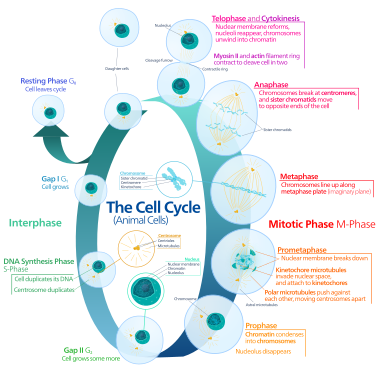
The growth process of the cell does not refer to the size of the cell, but the density of the number of cells present in the organism at a given time. Cell growth pertains to the increase in the number of cells present in an organism as it grows and develops; as the organism gets larger so does the number of cells present. Cells are the foundation of all organisms and are the fundamental unit of life. The growth and development of cells are essential for the maintenance of the host and survival of the organism. For this process, the cell goes through the steps of the cell cycle and development which involves cell growth, DNA replication, cell division, regeneration, and cell death. The cell cycle is divided into four distinct phases: G1, S, G2, and M. The G phase – which is the cell growth phase – makes up approximately 95% of the cycle. The proliferation of cells is instigated by progenitors. All cells start out in an identical form and can essentially become any type of cells. Cell signaling such as induction can influence nearby cells to differentiate determinate the type of cell it will become. Moreover, this allows cells of the same type to aggregate and form tissues, then organs, and ultimately systems. The G1, G2, and S phase (DNA replication, damage and repair) are considered to be the interphase portion of the cycle, while the M phase (mitosis) is the cell division portion of the cycle. Mitosis is composed of many stages which include, prophase, metaphase, anaphase, telophase, and cytokinesis, respectively. The ultimate result of mitosis is the formation of two identical daughter cells.
The cell cycle is regulated by a series of signaling factors and complexes such as cyclins, cyclin-dependent kinase, and p53. When the cell has completed its growth process and if it is found to be damaged or altered, it undergoes cell death, either by apoptosis or necrosis, to eliminate the threat it can cause to the organism's survival.[21]
Pathology
The scientific branch that studies and diagnoses diseases on the cellular level is called cytopathology. Cytopathology is generally used on samples of free cells or tissue fragments, in contrast to the pathology branch of histopathology, which studies whole tissues. Cytopathology is commonly used to investigate diseases involving a wide range of body sites, often to aid in the diagnosis of cancer but also in the diagnosis of some infectious diseases and other inflammatory conditions. For example, a common application of cytopathology is the Pap smear, a screening test used to detect cervical cancer, and precancerous cervical lesions that may lead to cervical cancer.
Notable cell biologists
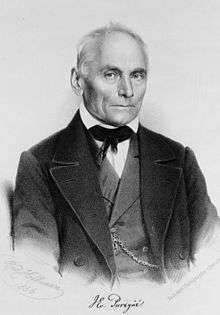
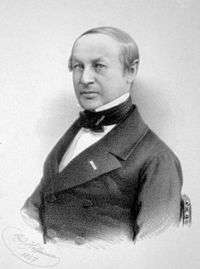 Theodor Schwann discoverer of the Schwann cell.
Theodor Schwann discoverer of the Schwann cell..jpg) Yoshinori Ohsumi Nobel Prize winner for work on autophagy.
Yoshinori Ohsumi Nobel Prize winner for work on autophagy.
See also
| Wikimedia Commons has media related to Cell biology. |
- The American Society for Cell Biology
- Cell biophysics
- Cell disruption
- Cell physiology
- Cellular adaptation
- Cellular microbiology
- Institute of Molecular and Cell Biology (disambiguation)
- Organoid
- Outline of cell biology
Notes
- Bisceglia, Nick. "Cell Biology". Scitable. www.nature.com.
- Hooke, Robert (September 1665). Micrographia.
- Gupta, P. (1 December 2005). Cell and Molecular Biology. Rastogi Publications. p. 11. ISBN 978-8171338177.
- Kendrick, Karolyn (1 January 2010). Chemistry in Medicine. Benchmark Education Company. p. 26. ISBN 978-1450928526.
- Lavanya, P. (1 December 2005). Cell and Molecular Biology. Rastogi Publications. p. 11. ISBN 978-8171338177.
- Cooper, Geoffrey M. (2000). "Tools of Cell Biology". The Cell: A Molecular Approach. 2nd Edition.
- McKinnon, Katherine M. (21 February 2018). "Flow Cytometry: An Overview". Current Protocols in Immunology. 120: 5.1.1–5.1.11. doi:10.1002/cpim.40. ISSN 1934-3671. PMC 5939936. PMID 29512141.
- Doble, Mukesh; Gummadi, Sathyanarayana N. (5 August 2010). Biochemical Engineering. New Delhi: Prentice-Hall of India Pvt.Ltd. ISBN 978-8120330528.
- Kaneshiro, Edna (2 May 2001). Cell Physiology Sourcebook: A Molecular Approach (3rd ed.). Academic Press. ISBN 978-0123877383.
- Nelson, Daniel (22 June 2018). "The Difference Between Eukaryotic And Prokaryotic Cells". Science Trends. doi:10.31988/scitrends.20655.
- Griffiths, Anthony JF; Miller, Jeffrey H.; Suzuki, David T.; Lewontin, Richard C.; Gelbart, William M. (2000). "Bacterial conjugation". An Introduction to Genetic Analysis. 7th Edition.
- "The Morphology of Eukaryotic Cells: Shape, Number and Size". YourArticleLibrary.com: The Next Generation Library. 19 March 2014. Retrieved 22 November 2015.
- De Rooij, Johan (25 June 2019). "F1000Prime recommendation of Force Triggers YAP Nuclear Entry by Regulating Transport across Nuclear Pores". doi:10.3410/f.732079699.793561846. Cite journal requires
|journal=(help) - "Endoplasmic Reticulum (Rough and Smooth) | British Society for Cell Biology". Retrieved 6 October 2019.
- Pelley, John W. (2007), "Citric Acid Cycle, Electron Transport Chain, and Oxidative Phosphorylation", Elsevier's Integrated Biochemistry, Elsevier, pp. 55–63, doi:10.1016/b978-0-323-03410-4.50013-4, ISBN 9780323034104
- Cooper, Geoffrey M. (2000). "The Golgi Apparatus". The Cell: A Molecular Approach. 2nd Edition.
- Verity, M A. Lysosomes: some pathologic implications. OCLC 679070471.
- Cooper, Geoffrey M. (2000). "Transport of Small Molecules". The Cell: A Molecular Approach. 2nd Edition.
- Ahmad, Maria; Kahwaji, Chadi I. (2019), "Biochemistry, Electron Transport Chain", StatPearls, StatPearls Publishing, PMID 30252361, retrieved 20 October 2019
- Schlessinger, Joseph (October 2000). "Cell Signaling by Receptor Tyrosine Kinases". Cell. 103 (2): 211–225. doi:10.1016/s0092-8674(00)00114-8. ISSN 0092-8674. PMID 11057895.
- Shackelford, R E; Kaufmann, W K; Paules, R S (February 1999). "Cell cycle control, checkpoint mechanisms, and genotoxic stress". Environmental Health Perspectives. 107 (suppl 1): 5–24. doi:10.1289/ehp.99107s15. ISSN 0091-6765. PMC 1566366. PMID 10229703.
References
- Penner-Hahn, James E. (2013). "Chapter 2. Technologies for Detecting Metals in Single Cells. Section 4. Intrinsic X-Ray Fluorescence". In Bani, Lucia (ed.). Metallomics and the Cell. Metal Ions in Life Sciences. 12. Springer. pp. 15–40. doi:10.1007/978-94-007-5561-1_2. ISBN 978-94-007-5560-4. PMID 23595669.electronic-book ISBN 978-94-007-5561-1 ISSN 1559-0836electronic-ISSN 1868-0402
- Cell and Molecular Biology by Karp 5th Ed., ISBN 0-471-46580-1

External links
| Wikibooks has more on the topic of: Cell biology |
| Library resources about Cell biology |
- Cell Biology at Curlie
- Aging Cell
- "Francis Harry Compton Crick (1916-2004)" by A. Andrei at the Embryo Project Encyclopedia
- "Biology Resource By Professor Lin."
